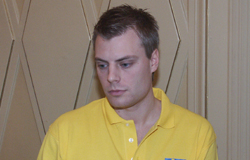| 36th World Team Championships, Monte Carlo, Monaco | Friday, 7 November 2003 |
Tough start
The trouble started on the first board of the match, when Peter Bertheau and Fredrik Nystrom let through a 3NT contract that should have been defeated while Eric Rodwell was making 10 tricks in diamonds at the other table. That was 11 IMPs for USA I right off the bat. The Swedes got 5 IMPs back on the second board in unusual fashion.
Rather than rebid his heart suit, Peter Fredin made a bid apparently designed to suggest both majors. Magnus Lindkvist, looking at six diamonds, thought that was a good place to stop. The diamond partial had no legitimate play, and it looked like another loss because 2©, although it can be defeated, might well make without perfect defense. Fredin did indeed go one off in 2¨ for minus 100. The Swedes still won the board, however.
This was not a success as Bertheau easily wrapped up eight tricks for plus 280. That was 5 IMPs to Sweden. On the following deal, Fredin got off to an unusual lead against a heart game, but the defense survived anyway.
In the open room, Fredin started with a low club from the South hand, and now Meckstroth had a chance since one of his two inevitable club losers had been eliminated. Declarer played a heart at trick two to the queen and ace, and the §10 was returned to declarer’s ace. Now a spade went to the queen and king and a spade was returned to the 9, jack and ace. At that point, Meckstroth was in a position to make the contract. The only losing play, looking at all the cards, was a low heart from dummy and a finesse. That is what happened, and when Fredin won his ©J, he cashed a club for one down and a push. On the following deal, Fredin and Lindkvist had to defend well to keep Meckstroth from landing another game contract.
With bad breaks in two key suits, Bertheau did not come to nine tricks after the lead of the ª7. That was plus 50 for USA I.
Meckstroth’s 1ª response to the Precision 1§ showed a positive
response with hearts. Fredin could not lead a spade to good effect,
and he had a better lead anyway – the ¨K. Meckstroth ducked
at trick one, and Fredin continued with the ¨Q. Meckstroth took
the ace and played a heart from hand. When Fredin followed with
the jack, Meckstroth accurately read it as a singleton and went
up with the ace. He then started in on clubs, playing the ace, king
and queen, ruffed by North with the 4 and overruffed by declarer. Board 28 was a tough one for Swedish partisans to take.
Soloway had no trouble with this contract, coming to 11 tricks for plus 660. In the open room, Meckstroth and Rodwell, with their busy, aggressive style, made life very difficult for Lindkvist and Fredin.
It’s hard to blame the Swedes for missing the notrump game. Lindkvist could hardly bid 3NT – his partner’s response did not promise a big hand, only four spades. When the auction came back to Fredin, he was also poorly placed in the bidding. He would look very foolish bidding 3NT and finding partner with some weak holding in diamonds, which would be perfectly logical given the auction. Fredin managed to take nine tricks in hearts despite misguessing in trumps, but it was an 11-IMP loss nonetheless. Suddenly, Sweden was down by 14 IMPs, 24-10. It got worse on the next board.
The contract at both tables was 3NT by East. In the closed room,
Soloway and Hamman did not err in the defense, holding declarer
to eight tricks for plus 100. Fredin started with the ©6, to the 3, 8 and queen. Meckstroth then played a low diamond from hand and Fredin made the fatal mistake of playing low. Meckstroth put in the jack and Lindkvist ducked, but Meckstroth simply played a low diamond from dummy. Lindkvist won the king and got out with a club, but it was too late for the defenders. Meckstroth had four diamonds, one heart and two tricks in each of the black suits for nine tricks and plus 600. It’s a different story if Fredin puts in the ¨Q at trick two. If Meckstroth wins the ace and plays the ¨J, Lindkvist simply ducks, holding Meckstroth to two diamond tricks. If Meckstroth ducks the ¨Q, Fredin continues hearts and the defenders take three tricks in that suit with the ¨K still to come. That’s down one and a push instead of a 12-IMP loss. Sweden now trailed 36-10, which turned out to be the final score. |
||||||||||||||||||||||||||||||||||||||||||||||||||||||||||||||||||||||||||||||||||||||||||||||||||||||||||||||||||||||||||||||||||||||||||||||||||||||||||||||||||||||||||||||||||||||||||||||||||||
| Page 6 |


